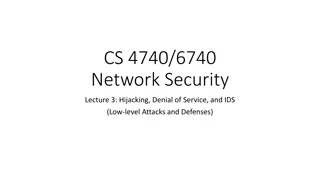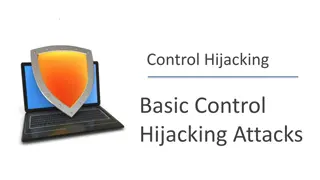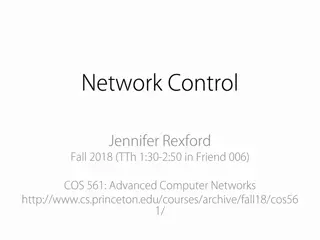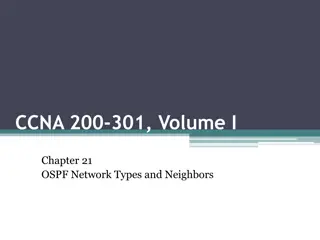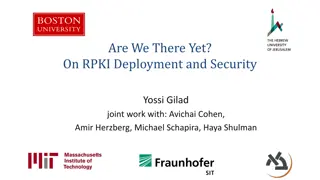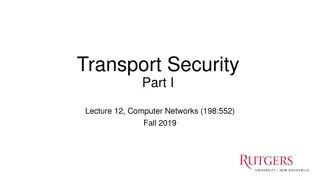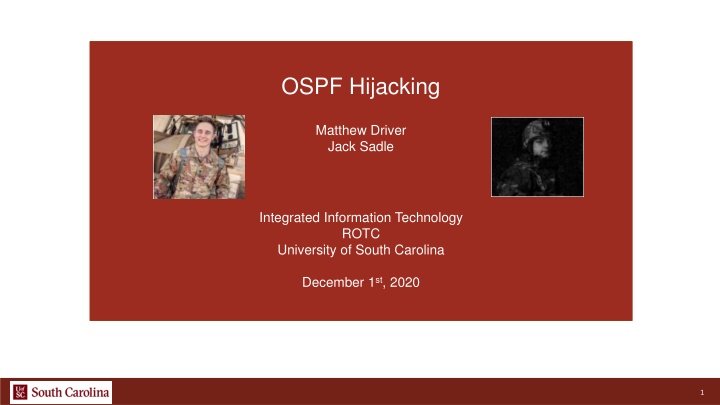
Mitigating OSPF Hijacking in Computer Networks
Safeguarding computer networks against OSPF hijacking involves understanding the risks posed by attackers manipulating routing protocols. This article covers the problem description, background information on OSPF, and proposes a solution through OSPF Authentication for enhanced network security.
Download Presentation

Please find below an Image/Link to download the presentation.
The content on the website is provided AS IS for your information and personal use only. It may not be sold, licensed, or shared on other websites without obtaining consent from the author. If you encounter any issues during the download, it is possible that the publisher has removed the file from their server.
You are allowed to download the files provided on this website for personal or commercial use, subject to the condition that they are used lawfully. All files are the property of their respective owners.
The content on the website is provided AS IS for your information and personal use only. It may not be sold, licensed, or shared on other websites without obtaining consent from the author.
E N D
Presentation Transcript
OSPF Hijacking Matthew Driver Jack Sadle Integrated Information Technology ROTC University of South Carolina December 1st, 2020 1
Agenda Introduction Problem description Background information Open Shortest Path First Hijacking Proposed solution and Implementation Conclusion 2
Problem Description Computer networks can be attacked by disrupting peer network routers. Using OSPF (Open Shortest Path First), routers send data to each other in a network via packets on routes that are established based on their distance to each other. In an OSPF network, the packet will take the shortest path along the routers in the network to get to their destination. Attackers can falsify the information carried within the routing protocols, thus hijacking IP addresses. This is done when an attacker manipulates the OSPF routing protocol so that traffic is misdirected to a rogue router projecting false routes. Attacks occur frequently across the world; e.g., see figure. 3
Problem Description Spoofing routing information can generally be used to cause systems to misinform (lie to) each other, cause a Denial of Service (DoS) attack, and redirect traffic to follow a path it would not normally follow. These kinds of threats to data security can cause the theft of information, shutdowns, and many other harmful results. Real shortest path R2 R3 R4 R1 Destination network Hijacked route Malicious router https://www.cloudflare.com/learning/security/glossary/bgp-hijacking/ 4
Background Information OSPF is perhaps the most widely used routing protocol in the world. It was developed so that the shortest path through a network is calculated based on the cost of the route, taking in account the bandwidth, delay and load. OSPF routers are configured by adding the adjacent Local Area Networks (LANs) and Wide Area Networks (WANs) to its routing table. A router would add the networks connecting all other routers in order to establish OSPF communication with these devices. These entries in the routing table have established distances so that the OSPF protocol can identify the shortest path to a destination network. In order to hijack an OSPF route, a rogue router advertises a shorter route to a legitimate network, therefore adding itself as the more viable route in the routing table. 5
Proposed Solution and Implementation The proposed solution to minimize an attack on an OSPF network is to implement OSPF Authentication on each router. Each router should have a password to authenticate, each of different characters. This is an OSPF Topology with an active spoofed router trying to infiltrate the network To combat security issues, we implement authentication measures on all routers through each interface 6
What is Router Authentication? Authentication is for security The risks of having no authentication means a rogue router may enter the network and gather data from the net OSPF supports 3 types of authentications: Null (none) Simple Password Authentication MD5 Authentication MD5 is the safest method of authentication because it is calculated using the MD5 Algorithm and is never exchanged by peers. 7
Router Authentication Process R1 will combine the shared secret key with the routing message creating what is called a hash Using the MD5 Algorithm, a digital signature is calculated and sent to R2 R2 will receive the message R2 will then combine the shared secret key with the routing message R2 will use the MD5 Algorithm to calculate the digital signature If the Digital signatures match, R2 will accept the OSPF update packets If the digital signatures do not match, R2 will not accept the OSPF update packets 8
Conclusion OSPF Hijacking can do massive damage with relative ease Attackers manipulate the OSPF routing protocol to steal network traffic Implementing authentication measures can help protect networks from these attacks 9


